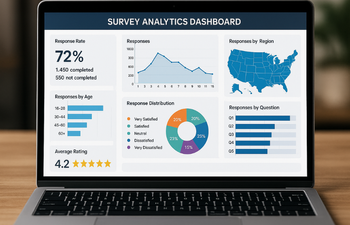Anonymous vs. Identifiable Surveys: Pros, Cons, and When to Use Each
Explore the differences, advantages, and ideal use cases of anonymous vs. identifiable surveys in this comprehensive guide.

Introduction
Surveys are a cornerstone of data collection in everything from academic research to employee engagement. But one fundamental decision often shapes the entire survey process: should the survey be anonymous or identifiable? Each option has distinct benefits and challenges, influencing response rates, data quality, and even ethical considerations.
Understanding the differences between these two types of surveys can significantly impact the effectiveness of your research. In this guide, we’ll dissect the pros and cons of anonymous vs. identifiable surveys and help you determine when to use each.
Anonymous Surveys
What Are Anonymous Surveys?
Anonymous surveys are structured so that no identifying information about the respondent is collected. This can mean no names, email addresses, IP addresses, or device IDs are stored.
Advantages of Anonymous Surveys
- Encourages honest and candid feedback
- Reduces social desirability bias
- Increases response rates for sensitive topics
- Simplifies ethical and compliance requirements
People often feel freer to speak their minds when they know they won’t be identified. This is particularly useful in employee feedback surveys, whistleblower reports, and studies involving personal behavior or opinions.
For insights on balancing open-ended and closed-ended questions in surveys, visit Open-Ended vs. Closed-Ended Questions: Which Should You Use in Your Next Survey?.
Disadvantages of Anonymous Surveys
- Limits follow-up opportunities
- Reduces accountability in responses
- Makes data validation difficult
- Cannot correlate responses over time
Anonymous responses can't be tied back to a specific individual, which means follow-up questions or longitudinal tracking become impossible. This can hinder deeper data insights.
Identifiable Surveys
What Are Identifiable Surveys?
Identifiable surveys collect some form of personal information from respondents, such as names, email addresses, or employee IDs. This allows responses to be connected to individuals.
Advantages of Identifiable Surveys
- Enables follow-up communication
- Allows for personalized analysis
- Supports longitudinal tracking and trend analysis
- Improves data validation and authenticity
Identifiable surveys are often used in longitudinal studies, customer relationship management, or performance reviews where personalized insights are critical.
For strategies to combat survey fatigue and improve engagement, check out Survey Fatigue Is Real: How to Spot It and What You Can Do About It.
Disadvantages of Identifiable Surveys
- May suppress honest feedback
- Increases privacy concerns
- Requires stricter data protection compliance
- Can result in lower participation rates
When participants are identifiable, they may be less willing to provide critical or sensitive feedback, especially in organizational settings.
When to Use Anonymous Surveys
Anonymous surveys are ideal when:
- The topic is sensitive or controversial
- Honest feedback is prioritized over follow-up
- You are conducting preliminary research
- There are concerns about retaliation or social judgment
Examples include mental health assessments, employee exit interviews, or customer service complaints.
When to Use Identifiable Surveys
Identifiable surveys are better suited for:
- Customer satisfaction tracking
- Employee performance reviews
- Academic longitudinal studies
- Personalized user experience research
In these contexts, connecting feedback to individuals helps paint a clearer picture of behavior over time.
Ethical Considerations
Whether you choose anonymous or identifiable formats, ethical responsibility is paramount.
- Always obtain informed consent
- Clearly state the purpose and data usage
- Offer opt-out options when possible
- Ensure secure data storage and access
Transparency builds trust, especially when dealing with identifiable information.
Legal and Compliance Requirements
Different regions have different regulations concerning data privacy. GDPR, HIPAA, and other legal frameworks impose stringent requirements on identifiable data. Make sure your survey complies with the relevant laws in your jurisdiction.
Technical Implementations
The implementation can also affect the anonymity of your survey. Even if no names are asked, technical details like IP logging can inadvertently reveal identities. Use platforms that support true anonymity if needed.
Case Study: Employee Feedback
An international tech company opted for anonymous surveys to gather feedback during a major restructuring. The result was a 60% increase in participation and more actionable insights about leadership and morale.
Case Study: Customer Loyalty Survey
A SaaS company used identifiable surveys linked to customer accounts. They were able to track satisfaction trends over a year and adjust their product roadmap based on segmented feedback.
Tools That Support Both Options
Some survey platforms offer both anonymous and identifiable modes. Look for customizable settings like:
- Toggleable metadata collection
- Customizable user tracking
- Informed consent prompts
Popular tools include Google Forms, Typeform, and SurveyMonkey, each with flexible options.
Data Analysis Differences
Anonymous data often requires different analytical techniques. You may focus more on content analysis, pattern recognition, or thematic grouping, rather than demographic segmentation.
Combining Both Approaches
Some surveys include a mix, anonymous questions followed by optional identifiable sections. This hybrid approach can offer the best of both worlds but must be communicated transparently.
Ensuring Survey Integrity
To avoid biased or duplicate responses in anonymous surveys, you can use CAPTCHA, logic checks, or session tracking, without compromising anonymity.
Impact on Data Quality
While anonymity might increase honesty, it also opens the door to careless or frivolous answers. Design your survey to balance trust and accountability.
Respondent Trust
People are more likely to engage with surveys when they trust the process. This means clearly stating whether the survey is anonymous or identifiable and explaining why.
Communication Tips
When inviting participants:
- Be clear about anonymity or identification
- Emphasize confidentiality measures
- Mention how the data will be used
- Provide contact info for questions
Future Trends
With growing privacy concerns and advancements in AI, expect more tools offering dynamic survey modes, adapting between anonymous and identifiable formats based on context.
Anonymous vs. Identifiable Surveys
In summary, anonymous surveys are ideal for gathering candid feedback, especially on sensitive issues. Identifiable surveys, however, offer deeper insights and personalized data use. The choice depends on your objectives, audience, and ethical obligations.
Conclusion
Choosing between anonymous and identifiable surveys isn't always black and white. It’s about balancing data quality, respondent comfort, and project goals. By understanding the strengths and limitations of each, you can design surveys that are not only effective but also respectful and compliant.
Frequently Asked Questions
Find answers to the most common questions about this topic
Anonymous surveys do not collect personally identifiable information, whereas identifiable surveys do.
Use anonymous surveys when you want to encourage honest feedback on sensitive or personal topics.
Not necessarily. Identifiable surveys can improve data validation, but anonymous ones may yield more candid responses.
Yes, if no metadata or personal identifiers are collected during the survey.
It's technically possible, but it should be made clear to respondents when their responses become identifiable.
You must ensure informed consent, data security, and respect for privacy when collecting identifiable data.








